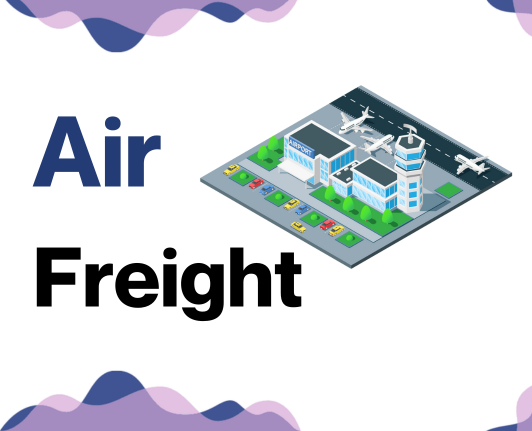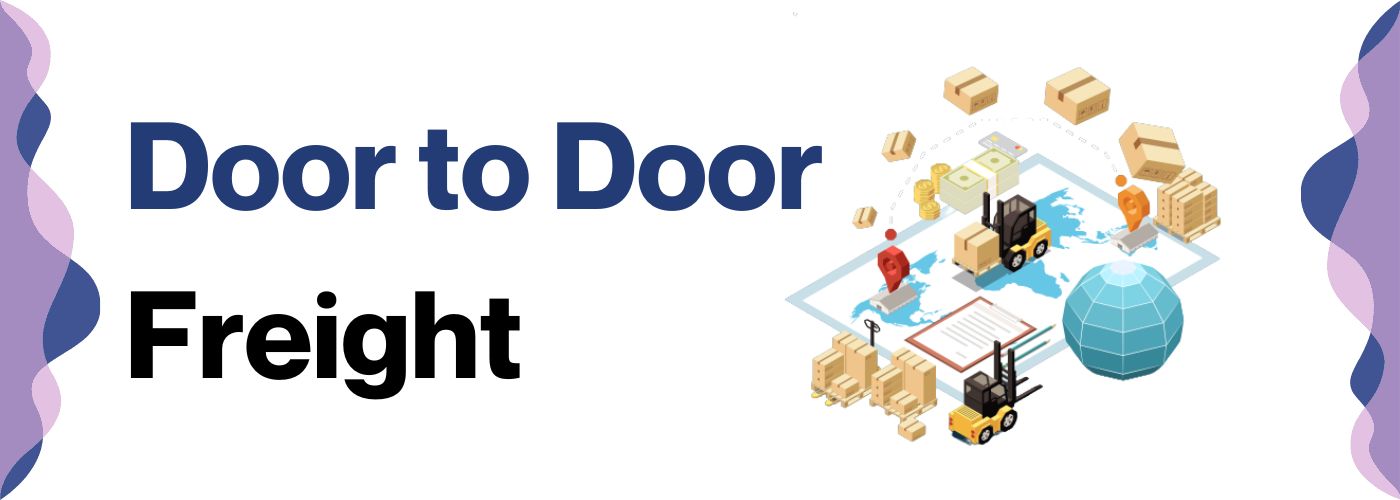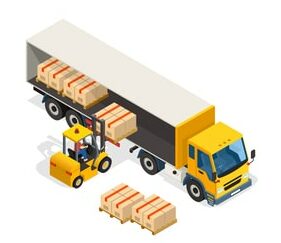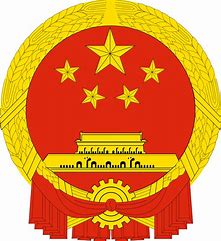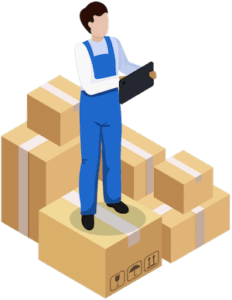Ever wondered why your shipment from China to South Korea felt like a giant game of Where's Waldo? You're not alone. The challenges of decoding rates, grappling with transit times, or deciphering customs regulations can turn a simple task into a logistical labyrinth. This detailed guide will help you discover the ins and outs of freight options between these two economic powerhouses, whether that is by air, sea, road, or rail. You'll learn about the intricacies of customs clearance as well as demystifying the terminology around duties and taxes. We'll equip you with practical tips and advice to ease the shipping process for your business. If the process still feels overwhelming, let DocShipper handle it for you! As your end-to-end international freight forwarder, we transform these daunting challenges into a seamless success story for your business.
Which are the different modes of transportation between China and South Korea?
Shipping between China and South Korea isn't as simple as mailing a letter. It's like choosing the shortest line at an amusement park - you need to consider the options and what you're carrying. Air freight is fast but pricey. Sea freight is cheaper and can handle heavy loads, but takes time, just like a scenic boat trip. For lighter goods, road transport could weave through like a bicycle, though it has its challenges. Picking the right mode is like choosing the quickest, most cost-effective ride. Think - what's your 'cargo-carrying' roller coaster?
How can DocShipper help?
Shipping goods from China to South Korea? Experience stress-free logistics with DocShipper. We coordinate transport, handle customs, and ensure swift delivery. Interested in a hassle-free trading journey? Request your free estimate now or dial up our consultants for a breezy chat. Transparency, efficiency, and simplicity - all at your service!
DocShipper Tip: Sea freight might be the best solution for you if:
- You are shipping large volumes or bulky items, as sea freight offers the most space at a cost-effective rate.
- Your cargo doesn't have an urgent deadline, as sea freight typically has longer transit times compared to air or rail.
- Your shipping routes are between major ports, allowing you to leverage the extensive global network of sea shipping lanes.
Sea freight between China and South Korea
Ocean shipping between China and South Korea is a bustling corridor of international trade, given their close proximity and robust economic ties. Key cargo ports connect major industrial hubs, forming an effective shipping network across the Yellow Sea. Suppose you're a business looking to transport high-volume goods cost-effectively; in that case, sea freight works as a slow yet affordable ally. A haul of teddy bears shuffling along this route may take time, but they'll march at a price that won't break your bank.
Here's the rub. Many businesses grapple with difficulties during shipping, often tripping on the same hurdles. Think of it as walking through a maze while blindfolded, easy to get lost, right? But fret not! This guide is your satellite view of this maze. We'll sail through specifics, from best practices to correct customs procedures that can help avoid common blunders. By the end of this guide, you'll be far more confident in chartering your cargo on the China-South Korea sea route — essentially, sailing smoothly and saving money!
Main shipping ports in China
Port of Shanghai
Location and Volume: The Port of Shanghai, on the East China Sea, is not only the world's largest sea port but also plays a pivotal role in the booming trade of the Yangtze River area. With a shipping volume surpassing 43.3 million TEUs in 2020, this powerhouse port handles vast quantities of cargo daily.
Key Trading Partners and Strategic Importance: The main trading partners include the United States, Japan, Hong Kong, and South Korea. It’s strategically important as China's leading export gateway and as a crucial global logistics hub.
Context for Businesses: If you're focused on reaching high-density markets and need a port with substantial capacity, the Port of Shanghai, with its supreme throughput, could be an indispensable ally in your logistics strategy.
Port of Ningbo-Zhoushan
Location and Volume: Situated at the crossroads of the north-south inland and coastal shipping route and the east-west trans-Pacific shipping route, the Port of Ningbo-Zhoushan handled over 29 million TEUs in 2020.
Key Trading Partners and Strategic Importance: Its key trading partners are the United States, the European Union, and Australia. The port is of strategic importance due to its role in facilitating international trade and its status as the world's largest port in terms of tonnage.
Context for Businesses: If you're seeking a gateway to reach both domestic and international markets via diverse shipping routes, the Port of Ningbo-Zhoushan could be your ideal solution.
Port of Shenzhen
Location and Volume: The Port of Shenzhen , found on the eastern bank of the Pearl River Estuary, is another colossal Chinese port, with a shipping volume of approximately 27.2 million TEUs in 2020.
Key Trading Partners and Strategic Importance: Its largest trading partners are in Asia, Europe, and North America. The port's proximity to Hong Kong enhances its strategic importance as an international freight hub.
Context for Businesses: If speed and connectivity are critical to your business, the Port of Shenzhen's advanced infrastructure and extensive network can offer you the competitive advantage you need.
Port of Guangzhou
Location and Volume: Based at the Pearl River Delta, the Port of Guangzhou is one of the oldest transport hubs in China, with a volume above 22 million TEUs in 2020.
Key Trading Partners and Strategic Importance: Its main trading partners include ASEAN nations, the United States, and the European Union. The port's notable strategic importance lies in its unique role in promoting the development of the entire Pearl River region.
Context for Businesses: If your strategy relies on historical trade routes and established business relationships, the Port of Guangzhou could be a beneficial asset.
Port of Qingdao
Location and Volume: Set on the Yellow Sea in Shandong Province, the Port of Qingdao was responsible for more than 21 million TEUs in 2020.
Key Trading Partners and Strategic Importance: The port's trading partners span from Asia to Europe and the Americas. It holds strategic importance due to its key position in the Asia-Europe trade route and integration into China's Belt and Road Initiative.
Context for Businesses: If trading with Europe and diversifying your logistics portfolio is your priority, completing shipments through the Port of Qingdao can create significant advantages.
Port of Tianjin
Location and Volume: Neighboring Beijing, the Port of Tianjin caters to China's northern provinces and serves as the maritime gateway to the nation's capital, with a volume over 16 million TEUs in 2020.
Key Trading Partners and Strategic Importance: It conducts trade mainly with the Asian Pacific region, North America, and Europe. Its strategic importance is compounded by its role in supplying Beijing and its proximity to the national railway system.
Context for Businesses: If your operations necessitate efficient transport to Northern China, the Port of Tianjian’s strategic location, combined with its vast service range, can accommodate your needs.
Main shipping ports in South Korea
Port of Busan
Location and Volume: Located at the southeastern tip of the Korean Peninsula, the Port of Busan serves as an international hub port in the Northeast Asia region. It is essential for trade activities flowing in and out of the Korean peninsula, boasting a shipping volume of over 20 million TEU.
Key Trading Partners and Strategic Importance: Major trading partners include China, the United States, Japan, and several Southeast Asian countries. The port's strategic role cannot be understated, as it consistently ranks as one of the busiest ports in the world.
Context for Businesses: If your shipping strategy aims to tap into Northeast Asian markets, then the Port of Busan, with its extensive connectivity and high shipping volume, should be a priority.
Port of Incheon
Location and Volume: Situated on the northwest coast of Korea, the Port of Incheon serves as the country's second-largest trading post. Handling over 3 million TEU annually, it offers efficient access to the metropolitan areas of the Korean peninsula.
Key Trading Partners and Strategic Importance: It maintains strong ties with China and Japan, while also having extensive routes to Russia, Southeast Asia, and the Americas. This port holds strategic importance due to its relative proximity to Seoul and Gimpo International Airport.
Context for Businesses: The Port of Incheon may be a key location if your business plans to reach customers in the heavily populated regions of South Korea, thanks to its proximity to Seoul and integrated transport hub.
Port of Gwangyang
Location and Volume: Located on the southwest coast of Korea, the Port of Gwangyang is the country’s second-largest port. It has a shipping volume of over 2.5 million TEU, serving predominantly as a bulk and container port.
Key Trading Partners and Strategic Importance: Key trading partners encompass China, Singapore, and the United States. It's strategically important as it houses South Korea's largest steel-making company, POSCO, boosting trade in iron and steel.
Context for Businesses: If your business involves the export or import of heavy industries like steel, the Port of Gwangyang, with its specialized infrastructure, can be an integral part of your supply chain.
Port of Ulsan
Location and Volume: Positioned on the southeast coast of Korea, the Port of Ulsan is pivotal for the oil and automobile industry. It handles approximately 1.9 million TEU annually.
Key Trading Partners and Strategic Importance: The port maintains dynamic trading relationships with China, Japan, Singapore, and Saudi Arabia. It further holds strategic importance as it is home to Hyundai Motors and the country's largest petroleum complex.
Context for Businesses: If your business is in the petroleum or automobile industries, the Port of Ulsan, featuring a well-connected network and specialized facilities, would likely be a significant asset to your logistics operations.
Port of Pyeongtaek-Dangjin
Location and Volume: Located in the west coast region of Korea, the Port of Pyeongtaek-Dangjin is central to the steel and car industry, processing over 1.6 million TEU per year.
Key Trading Partners and Strategic Importance: Main trading partners include China, the United States, Australia, and Indonesia. The port gains its strategic importance from being home to Hyundai Steel’s Dangjin Steel Works and numerous car carrier terminals.
Context for Businesses: The Port of Pyeongtaek-Dangjin, thanks to its solid infrastructure for heavy industry, can be a crucial part of your supply chain if your business centers on steel production or automobile exports.
Port of Mokpo
Location and Volume: Situated on the southwestern tip of the Korean peninsula, the Port of Mokpo is crucial for fishing and agricultural trade, handling over 1 million TEU annually.
Key Trading Partners and Strategic Importance: The port primarily has active trade relations with regional Asian partners. Its strategic importance comes from its geographical location, particularly close to China, and its specialization in agricultural products and seafood.
Context for Businesses: If you're in the food and agricultural sector aiming to extend your reach within Asian markets, the Port of Mokpo, with its specialized facilities and strategic position, can be the perfect fit for your shipping strategy.
Should I choose FCL or LCL when shipping between China and South Korea?
Shipping goods between China and South Korea? Whether it's car parts, electronics, or textiles, you'll likely face a significant decision: opting for Full Container Load (FCL) or Less than a Container Load (LCL), also known as consolidation. This isn't just a logistical choice, it's a strategic one. It affects your bottom line, your delivery times, and overall, your shipment success. Ready to dive into the nitty-gritty details of both options? Let's empower you to make that informed decision. The right choice can ensure smooth sailing for your cargo. Prepare for a deep sea of knowledge!
LCL: Less than Container Load
Definition: LCL (Less than Container Load) shipping is a method of sea freight, where your cargo occupies a portion of a larger, shared container.
When to Use: If your cargo is less than 13/14/15 CBM, LCL shipment is often the better choice. It offers price flexibility and accommodates low volume shipments, making it a very practical option for small and medium-sized businesses.
Example: Imagine you're a toy manufacturer in Beijing sending 10 CBM of toys to a distributor in Seoul. Instead of paying for a full container you don't need, you can use the LCL freight service and share the container space and shipping costs with other businesses.
Cost Implications: With LCL, you only pay for the space you use which can significantly reduce your shipping costs. However, bear in mind that LCL often has other administrative charges like LCL handling fees, which can add to your total freight costs. Therefore, asking for an LCL shipping quote that includes all associated costs upfront will be helpful in understanding the total shipment cost.
FCL: Full Container Load
Definition: Full Container Load (FCL) shipping is a method where your goods are loaded into a 20'ft or 40'ft container, which remains sealed from origin to destination.
When to Use: FCL is the go-to choice if your cargo is more than 13/14/15 CBM. This is because it's cost-effective for high volumes, with a single FCL shipping quote typically covering all goods within the container. Beyond cost, FCL also ensures safety as your goods are the only items within it.
Example: To illustrate, imagine you're a toy manufacturer shipping 500 boxes of toys between China and South Korea. The order perfectly fills a 20'ft FCL container. The container is sealed off at your factory in China and only reopened upon reaching your client in South Korea, minimizing potential for damage or loss.
Cost Implications: Given the high volume of goods, FCL is more affordable per unit compared to Less than Container Load (LCL). With LCL, you'd pay for each CBM, whereas FCL charges are based on the whole container. Finding the correct balance in FCL container selection, between a 20'ft and 40'ft, can lead to significant savings. Remember, while the FCL cost is cheap for higher volume, an under-filled container can become costly.
Unlock hassle-free shipping
Confused about the best shipping method between China and South Korea? DocShipper is here to ease the load. As an expert freight forwarder, our mission is to simplify cargo shipping for businesses like yours. Our ocean freight specialists consider crucial factors such as volume, deadline, and budget to help decide between consolidation or full container shipping. Don't mull over - seek the tailored expertise you deserve. Click for a free estimation today. Let us make your shipping decision stress-free.
How long does sea freight take between China and South Korea?
Shipping goods between China and South Korea by sea freight usually takes around 2 to 4 days on average. However, keep in mind that transit times can vary due to a number of factors like the specific ports being used, the weight of your cargo, and the nature of the goods being shipped. For an accurate and tailored quote based on your unique shipping needs, you may want to reach out to a reliable freight forwarder such as DocShipper.
Here's a quick reference for you, outlining the average transit times for sea freight between the main ports in China and South Korea:
| China Ports | South Korea Ports | Average Transit Time |
| Shanghai | Busan | 3 |
| Ningbo | Incheon | 3 |
| Shenzhen | Gwangyang | 4 |
| Guangzhou | Ulsan | 4 |
Remember, these are just approximations. For precise scheduling and pricing, we recommend getting in touch with your freight forwarder.
How much does it cost to ship a container between China and South Korea?
Ocean freight rates between China and South Korea sway like a ship on high seas - you might be looking at a broad range from $20 to $100 per Cubic Meter (CBM). Shipping cost doesn't have a one-size-fits-all tag due to factors like Point of Loading, Destination, choice of carrier, type of goods, and even the unpredictability of monthly market fluctuations. It can feel like navigating choppy waters, but don’t worry! Our savvy shipping specialists make it their mission to work out the most competitive costs tailored to your needs, quoting on a case-by-case basis. Rest assured, we'll steer you towards the best rates.
Special transportation services
Out of Gauge (OOG) Container
Definition: OOG containers are specialized shipping solutions for out of gauge cargo that exceed standard container dimensions.
Suitable for: Oversized equipment, construction materials, and heavy machinery.
Examples: Construction equipment such as bulldozers and cranes, windmill propellers, or large statues.
Why it might be the best choice for you: If your cargo is too big for standard containers, an OOG container provides the flexibility you need, while keeping your transport straightforward and cost-effective.
Break Bulk
Definition: Break bulk refers to cargo that must be loaded individually, not in containers or bulk, due to their shape or size.
Suitable for: Large items that can't be broken down into smaller units.
Examples: Oversized construction materials, such as steel beams or large timber, and large machinery.
Why it might be the best choice for you: Break bulk shipping is optimal if you're shipping loose cargo load that can't be easily containerized or your cargo is so large it takes up an entire shipload.
Dry Bulk
Definition: Dry bulk shipping refers to the transportation of homogeneous bulk cargo in unpackaged form, in large quantities.
Suitable for: Commodities like grain, coal, or iron ore.
Examples: Sand, cement, or fertilizers shipped in huge quantities.
Why it might be the best choice for you: If your merchandise consists of uncompressed, dry goods, dry bulk shipping can be an economical and efficient solution.
Roll-on/Roll-off (Ro-Ro)
Definition: In a ro-ro vessel, vehicles roll on at the point of origin and roll off at the destination point. This is in contrast to lift-on/lift-off (lo-lo) vessels which use a crane to load and unload cargo.
Suitable for: Motor vehicles and heavy equipment that can be wheeled.
Examples: Cars, trucks, semi-trailer trucks, trailers, and railroad cars.
Why it might be the best choice for you: If you're looking to transport vehicles or wheeled machinery, Ro-Ro offers a simple and efficient solution. These ships are specifically designed to carry self-propelled, towable or forkliftable cargo.
Reefer Containers
Definition: Reefer containers are refrigerated shipping containers for goods requiring temperature-controlled handling in transit.
Suitable for: Perishable products like food, pharmaceuticals, and plants.
Examples: Fresh fruits, vegetables, seafood, or specialty pharmaceuticals that need refrigeration.
Why it might be the best choice for you: This is your go-to option if you're exporting or importing goods that need to be kept at a steady, cool temperature throughout their journey.
No matter your international shipping needs, DocShipper can guide you in choosing the best sea freight option based on what suits your goods and business requirements best. If you're shipping from China to South Korea, don't hesitate to reach out for a free shipping quote in less than 24h.
DocShipper Tip: Air freight might be the best solution for you if:
- You are in a hurry or have a strict deadline requirement, as air freight offers the fastest transit times.
- Your cargo is less than 2 CBM (Cubic Meter), making it more suitable for smaller shipments.
- Your shipment needs to reach a destination that is not easily accessible by sea or rail, allowing you to tap into the extensive network of global airports.
Air freight between China and South Korea
For businesses looking to speedily transport high-value, compact goods from China to South Korea, air freight shines as the go-to choice. Picture flying the latest smartphone models or life-saving pharmaceuticals; the quick delivery pays off handsomely. This option helps you justly balance cost and speed, saving the headache of delayed shipments.
However, it's not always smooth sailing. Many shippers stumble into potholes, like miscalculating costs due to incorrect weight formulas, which can make budgets go haywire. Imagine expecting to pay for a poodle-sized shipment only to realize it's as pricey as a panda! We'll unravel these common slip-ups, helping you gain command over air freight intricacies.
Air Cargo vs Express Air Freight: How should I ship?
If you're contemplating the ideal way to transport goods from China to South Korea, it's time to get savvy about your options. In simple terms, air cargo means your goods travel alongside others in a regular airline, while express air freight whisks your shipment to its destination in a dedicated plane – faster, yet costlier. Depending on urgency, budget, and type of goods, your choice could tip the scale of your business efficiency. Dive in, let's decode the best fit for your enterprise.
Should I choose Air Cargo between China and South Korea?
Air cargo service can indeed meet your needs for a cost-effective and reliable shipping solution between China and South Korea. Leading airlines such as China Southern Airlines and Korean Air dedicate cargo routes on this path, presenting a dependable choice. Despite longer transit times caused by fixed schedules, these airlines ensure the safety of your freight, offering much-needed peace of mind. Especially if your shipment weighs around 100-150 kg (220-330 lbs), air cargo turns out to be more attractive, balancing cost and reliability efficiently. So, if budget consideration influences your shipping decisions, then air cargo is worth giving serious thought.
Should I choose Express Air Freight between China and South Korea?
Facing tight deadlines for your shipments under 1 CBM or 100/150kg from China to South Korea? Express Air Freight, a special service utilizing cargo-only aircraft, might be your best fit. Renowned international courier firms like FedEx, UPS, or DHL, provide this fast and reliable service. Whether it's critical documents or time-sensitive perishable goods, these carriers ensure your consignment reaches its destination promptly. So, if speed is your priority, consider Express Air Freight!
Main international airports in China
Beijing Capital International Airport
Cargo Volume: The airport handles over 2 million metric tonnes of cargo annually, making it one of the busiest cargo airports in China.
Key Trading Partners: Most cargo trade is with the United States, followed by Japan, South Korea, Australia, and Europe.
Strategic Importance: As China's second largest cargo hub, it plays a critical role in global commerce. Its proximity to China's political and economic power center enhances its strategic significance.
Notable Features: With three operational terminals and two modern cargo areas, the airport can efficiently handle high volumes of cargo.
For Your Business: Its extensive cargo handling capabilities and seamless connectivity to major global and domestic networks can ensure timely and efficient delivery of your goods.
Guangzhou Baiyun International Airport
Cargo Volume: This airport handled over 1.89 million metric tonnes in 2019, which is a testament to its impressive cargo handling capability.
Key Trading Partners: Major trade partners are Southeast Asian countries, the United States and Europe.
Strategic Importance: The airport is situated in southern China, acting as a gateway to the Asian market.
Notable Features: It features a state-of-the-art cargo terminal that can handle large cargo aircraft and offers a comprehensive range of freight handling services.
For Your Business: The airport's advanced cargo handling facilities coupled with its strategic location in southern China can accelerate your business growth by providing a faster route to the Asian market.
Pudong International Airport
Cargo Volume: It is the third busiest cargo airport globally, handling over 3.6 million metric tonnes of cargo each year.
Key Trading Partners: Cargo primarily moves between China, North America, and Europe.
Strategic Importance: Located in Shanghai, the economic hub of China, it plays an integral role in the country's logistics infrastructure.
Notable Features: Notably, the airport accommodates the largest global freight companies, boasting dedicated terminals for DHL, FedEx, and UPS.
For Your Business: It's robust infrastructure, and broad network connectivity can provide your business with access to major markets globally while ensuring reliable and efficient cargo movement.
Shenzhen Bao’an International Airport
Cargo Volume: In 2019, the airport handled over 1 million metric tonnes of cargo, ranking fifth in China.
Key Trading Partners: Major trading partners include East Asia, the Americas, and Europe.
Strategic Importance: As it's located in one of the fastest growing economic regions in China, it plays a key role in both domestic and international cargo movement.
Notable Features: The airport is the hub for SF Express, a leading courier services provider in China.
For Your Business: Positioning your goods at this airport allows your business to tap into the significant economic growth in the region, offering great potential for business expansion.
Chengdu Shuangliu International Airport
Cargo Volume: With an annual throughput of over 780,000 metric tonnes of cargo, it is the largest cargo hub in central and western China.
Key Trading Partners: It trades predominantly with Europe, the Americas, and East Asia.
Strategic Importance: Seen as the Gateway to Western China, it offers a strategic location for reaching this developing market.
Notable Features: The airport boasts two modern cargo terminals and a bonded logistics center.
For Your Business: The airport offers a broad range of comprehensive cargo services and an advantageous geographical position that can provide your business easy access to the Western Chinese market.
Main international airports in South Korea
Incheon International Airport
Cargo Volume: Incheon Airport handles approximately 2.91 million metric tons of air cargo annually, making it one of the busiest cargo airports globally.
Key Trading Partners: Major trading partners include China, the United States, Japan, Hong Kong, and Vietnam.
Strategic Importance: As the largest airport in South Korea, Incheon serves as the primary cargo gateway with its strategic location entre Asia and North America.
Notable Features: It offers advanced logistics facilities, with dedicated freight terminals and extensive warehouse storage.
For Your Business: If your business operates on a global scale, particularly with key Asian and American markets, Incheon's high cargo capacity and advanced facilities can efficiently accommodate your shipping needs.
Gimhae International Airport
Cargo Volume: Gimhae Airport handles over 123,000 metric tons of cargo annually.
Key Trading Partners: The primary trading partners are Japan, China, and Southeast Asian countries.
Strategic Importance: Located in Busan, Korea's second-largest city, Gimhae serves as a significant link to the southern parts of the country and international destinations.
Notable Features: It has a dedicated cargo terminal and direct access to the Busan Port, one of the busiest seaports worldwide.
For Your Business: If your trade routes include Southeast Asia or need to connect with maritime transport, consider incorporating Gimhae into your shipping strategy.
Jeju International Airport
Cargo Volume: Jeju International Airport handles over 30,000 metric tons of cargo annually.
Key Trading Partners: Primarily caters to domestic routes, but it also serves China, Japan, and Southeast Asia.
Strategic Importance: As the gateway to Jeju Island, this airport facilitates cargo transit to this isolated region.
Notable Features: It features a modern cargo terminal and a unique location for faster delivery to Jeju Island.
For Your Business: If your business involves shipping to Jeju Island, this airport's capabilities could offer convenient and quick options for you.
Muan International Airport
Cargo Volume: Muan International handles smaller cargo volumes compared to other Korean airports, mainly serving domestic cargo needs.
Key Trading Partners: Mostly serves domestic flights, with scheduled routes to Japan.
Strategic Importance: Geographically positioned in the southwest region, it serves areas with fewer transport options and caters to specific local industries.
Notable Features: It hosts a dedicated cargo terminal and specializes in handling domestic cargo.
For Your Business: If your business deals with the southwest regions of Korea or industries specific to this area, Muan International could be an optimal choice.
Yangyang International Airport
Cargo Volume: This airport primarily caters to passenger flights, with a relatively small yet growing cargo volume.
Key Trading Partners: A major proportion of international flights are destined for Japan, Russia, and Southeast Asian countries.
Strategic Importance: Located in Gangwon province, it provides a direct shipping route to local industries, including fisheries and agriculture.
Notable Features: Despite being a smaller airport, it features a cargo terminal that could cater to specific cargo needs.
For Your Business: If your shipping needs align with routes to northeastern Asia or local Korean industries, Yangyang International Airport may be a strategic addition to your routes.
How long does air freight take between China and South Korea?
Shipping between China and South Korea by air freight typically takes between 1 and 3 days. However, keep in mind that these are only average times and actual transit times can fluctuate based on factors such as the specific airports involved, the weight of your shipment, and the nature of your goods. To get exact times tailored to your unique shipping needs, it would be advantageous to consult with a knowledgeable freight forwarder like DocShipper.
How much does it cost to ship a parcel between China and South Korea with air freight?
Air freight costs between China and South Korea typically range around $3-$10 per kg. However, providing an exact rate is challenging due to various factors including distance, dimensions, weight, and nature of goods. Rest assured, our team is committed to working with each client individually to deliver the most cost-effective solution. Remember, each quote is customized to your specific needs and circumstances. Don't hesitate to get in touch - we can offer a free quote in less than 24 hours.
What is the difference between volumetric and gross weight?
Gross weight refers to the actual weight of your shipment, which includes all packaging and the goods within. On the other hand, volumetric weight takes into consideration the amount of space a shipment occupies, rather than the actual weight.
For air cargo, volumetric weight is calculated by multiplying the dimensions (Length x Width x Height in cm) of the package and dividing it by a standard figure (usually 6000). For example, a package with dimensions 50cm x 50cm x 50cm has a volumetric weight of (50x50x50)/6000, which equals 20.83kg, or approximately 45.9 lbs.
Gross weight is simply measured with a scale. For example, if your package weighs 15kg on the scale, that’s the gross weight, or about 33.07 lbs.
For Express Air Freight services, the calculation is similar, but the divisor differs. They use a standard of 5000 instead. Using the same dimensions, our calculation becomes (50x50x50)/5000, equating to 25kg, or approximately 55.12 lbs.
This matters because freight charges are based on whichever weight is higher between the gross and volumetric weight. Choosing the right packaging for your goods can significantly impact the final shipping cost.
DocShipper tip: Door to Door might be the best solution for you if:
- You value convenience and want a seamless shipping process, as door-to-door takes care of every step from pickup to delivery.
- You prefer a single point of contact, as door-to-door services typically provide a dedicated agent to handle all aspects of the shipment.
- You want to minimize the handling of your goods, reducing the risk of damage or loss, as door-to-door minimizes transitions between different modes of transport.
Door to door between China and South Korea
Ding dong! That's the sound of door-to-door shipping making global trade easy for you. This full-service approach covers the entire logistics process, from pick up in China right through to delivery in South Korea. Enjoy benefits like lower shipping cost, less effort, and streamlined customs clearance. Ready to unpack the details? Let's dive in!
Overview – Door to Door
Embarking on the shipping journey between China and South Korea? Door-to-door service is your stress-free solution, carrying your goods from warehouse to your desired location. It's a favorite among our clients at DocShipper, as it simplifies the complexities, nullifies challenges like customs clearance, and affords an extra layer of convenience. However, it might come with a slightly higher cost. But think about freeing up time and resources for what matters: your business. So, if peace of mind tops your list, let us handle your logistics complexities.
Why should I use a Door to Door service between China and South Korea?
Why become a logistics mastermind when you can just knock on the right door to get your goods shipped? That's exactly what a Door to Door service does for you when shipping between China and South Korea.
1. Stress-Free Logistics: Forget the headache of coordinating different transit modes. The service takes care of collection, freight, customs, delivery - the whole enchilada!
2. Timeliness: Urgent shipments? No problem. With tightly coordinated schedules, your goods are delivered just in time, like clockwork.
3. Specialized Care: Whether it's high-value electronics or delicate ceramics, handling complex cargo with care is their bread and butter.
4. Local Expertise: Struggling with foreign language paperwork? Don't sweat it! Native experts got your back, ensuring smooth customs clearance.
5. Convenience & Ease: Let them do the heavy lifting. Literally. Trucking is handled from your warehouse right up to the final destination.
Kick back and focus on what you do best - growing your business. Door to Door service - because why juggle when you can delegate!
DocShipper – Door to Door specialist between China and South Korea
Experience stress-free shipping from China to South Korea with DocShipper. Let us take care of everything, from packing to transport, customs to the choice of shipping method - we've got it all under control. We assign a dedicated Account Executive to you, ensuring every detail is managed, for a smooth, efficient shipment process. Reach out now for your free estimate within 24 hours or consult with our knowledgeable team at no charge. Trust DocShipper, your shipping solution experts.
Customs clearance in South Korea for goods imported from China
Customs clearance is vital when shipping goods from China to South Korea, acting as a regulatory checkpoint to levy duties on imported goods. The process can be riddled with complexities, often leading to unexpected costs and the risk of goods getting held up. From understanding customs duties and taxes to quotas and import licenses, it's critical to be well-versed to avoid missteps. Not to worry, we'll delve deeper into these areas in the following sections of the guide. And remember, the DocShipper team stands ready to assist with all processes, for any type of goods, anywhere globally. For an estimate, simply provide us with the goods' origin, value, and HS Code, and we'd be happy to assist further. Crafting strategic shipping plans is our forte, ensuring no detail is left unattended. Your logistics success story starts here.
How to calculate duties & taxes when importing from China to South Korea?
Cracking the code of importing goods from China to South Korea doesn't need to be daunting, especially when it comes to estimating duties and taxes. The crucial elements to keep in your shipping calculations include the country of origin, the HS Code, the customs value, the applicable tariff rate, and any additional taxes or fees that might apply to the products. Mastering these parameters can give your business a significant edge in managing the shipping costs.
Now, where to start? Let's begin at the roots - identifying the origin country, which is where the goods were produced or manufactured. This is an essential first step, and in our case it would be China. It's important to remember that the country of origin can potentially affect tariff rates, so make sure to get this right. Let's move on and unravel the other factors in the following sections.
Step 1 - Identify the Country of Origin
Recognizing your goods' Country of Origin unveils vital trade insights. First, it clarifies which customs regulations will apply, since this depends on the origin country. Second, it determines if any trade agreements reduce or eliminate duties. With China and South Korea, the China-Korea Free Trade Agreement lets certain goods enter duty-free.
Third, it highlights possible import restrictions, ensuring you avoid unnecessary headaches. South Korea, for example, has restrictions on certain goods from China, like agricultural and fisheries products. Fourth, it enables accurate calculation of shipping costs based on geographic distance and routes. Lastly, it provides a secure footing for obtaining the Harmonised System (HS) code, an international code system used for computing duties and taxes.
Remember, details like accurate country data could boost your chances of securing preferential tariffs. So, give due attention to defining the Country of Origin. It might seem a no-brainer, but taking this step seriously can lead to smooth sailing when navigating customs clearance.
Step 2 - Find the HS Code of your product
The Harmonized System Code, or HS Code, is a standardized numerical method of classifying traded products. It is used by customs authorities around the world to identify products when assessing duties and taxes and for gathering statistics.
Generally speaking, the easiest way to find the HS Code for your product is to ask your supplier. They should be familiar with the product they're exporting and the relevant regulations.
But if this isn't an option for you, don't worry. We're going to walk you through a straightforward process to dig it up yourself.
Your first step is to utilize an HS lookup tool. One such tool can be found on the Harmonized Tariff Schedule website.
Once you're there, input the name of your product into the search bar.
Next, check the Heading/Subheading column. This is where you'll find your HS code.
Remember, it's incredibly important to ensure the accuracy of your HS Code. Using the wrong code can result in delays and potentially even fines. So, always double-check before finalizing.
Here's an infographic showing you how to read an HS code.
Step 3 - Calculate the Customs Value
Understanding the Customs Value is crucial for your shipping plan. It's not directly the value of your goods; instead, it represents the CIF value, a combination of the cost of your goods, the expense of international shipping, and the insurance fee. Let's say you bought a batch of products for $1,000, shipping set you back by another $200, and the insurance charged was $50. Your Customs Value would then be $1,250. This value forms the basis for the calculation of customs fees upon arrival in South Korea. Remember, accuracy in your declarations is key to avoiding any unnecessary complications at the customs stage. So, your number know-how is going to be your winning ingredient in this shipping recipe.
Step 4 - Figure out the applicable Import Tariff
An import tariff is a tax imposed on goods imported into a country. In South Korea, the import tariff utilizes the Harmonized System (HS) for standardizing and classifying traded products.
Here's how to obtain and use this information:
1. Go to the Korea Customs Service website.
2. Input the HS code you identified earlier and China as the country of origin.
3. Assess the tariff rates for your product.
As a real-world example, let's use an HS code for a simple product like a bicycle (HS 8712). Assuming it's imported from China, you may find a tariff rate of 8%. If your Cost, Insurance, and Freight (CIF) is USD 200, the import duty can be calculated as follows: 8% of USD 200 = USD 16.
It's essential to understand these calculations to budget for import costs accurately and avoid any unpleasant surprises! Keep in mind that regulations may vary, so staying informed and up-to-date is crucial.
Step 5 - Consider other Import Duties and Taxes
Taking the leap from standard tariff rates, you'll find that additional import duties often come into play. These vary based on both the country of origin and the nature of the product itself. For instance, you may need to consider excise duty, designed to tax specific commodities like tobacco or petroleum.
Let's say for example purposes - you're importing branded cigarettes from China. An excise duty may apply in South Korea on top of the standard tariff.
Anti-dumping taxes may apply too. They combat the selling of exported goods below market price. If our hypothetical cigarette suppliers were found guilty of this, an additional levy would be imposed to balance the scales.
Lastly, there's a hard-hitter - VAT. Regardless of the product, this tax is typically unavoidable. In South Korea, the standard VAT rate is 10%. So, if you're shipping goods worth $10,000, you're likely looking at an extra $1,000 in VAT alone.
However, we must remind you that these are rough calculations. Both the product and the real-time legislation can impact these rates. Always double-check all figures and potential implications for an accurate financial forecast.
Step 6 - Calculate the Customs Duties
Mastering customs duties in South Korea for Chinese imports is like acing a tricky math problem. Here's how you solve it.
First, establish your customs value - this is usually your goods' price tag plus shipping and insurance costs. For instance, if your goods are worth $1000 and freight charges are $200, your customs value is $1200.
To calculate customs duties alone, apply the duty rate to your customs value. Say the duty rate is 10%; your customs duty is $120 (10% of $1200).
Next, add Value Added Tax (VAT) if required. South Korea's standard VAT is 10%, thus adding $120 to your fees.
However, anti-dumping taxes can flop into the mix. Say you're importing Chinese steel, and there's a 20% anti-dumping tax. Apply this to your customs value and VAT, hiking your costs by $240.
Throw Excise Duty into the mix, and your math problem gets a bit more challenging. Let's say there's a 15% Excise Duty applicable to your product. That's an additional $180 added to your total costs, making the entire customs expense $660.
Don’t fret - DocShipper is here to crunch these numbers for you. Our specialist team takes care of every step in the customs clearance process worldwide, ensuring you aren’t overcharged. Reach out to us anytime for a free quote delivered in less than 24 hours, tailored to your unique situation!
Does DocShipper charge customs fees?
As a customs broker in China and South Korea, DocShipper doesn't level customs duties, a duty directly paid to the government. However, we do charge for navigating customs clearance, a separate cost. For total transparency, we provide the documents issued by the customs office, ensuring you only pay what's demanded by the customs house. Think of it as two parts of the same package - just like you would pay for courier service and separately for the stamps needed to mail a parcel. The same applies in the world of freight forwarding.
Contact Details for Customs Authorities
China Customs
Official name: The General Administration of Customs of the People's Republic of China
Official website: http://english.customs.gov.cn/
South Korea Customs
Official name: Korea Customs Service
Official website: http://www.customs.go.kr/
Required documents for customs clearance
Ever scrambled to find the right paperwork for customs clearance? Don't stress. This section will decode those daunting documents - Bill of Lading, Packing List, Certificate of Origin, and Documents of Conformity (CE standard). Let's conquer this crucial step in international shipping together.
Bill of Lading
Unlocking successful trade between China and South Korea requires mastering the art of paperwork, and the Bill of Lading is your golden ticket. Think of it as the grand handshake on paper, confirming that ownership of the goods has officially transitioned. It's not just ceremonial, but practical too, holding all necessary info about the cargo, carrier, and consignee. Whether you're dealing with a Full Container Load or Less Than Container Load, this document is non-negotiable.
Got an urgent shipment? Consider the electronic - or 'telex' release. It's the e-version of the Bill of Lading, offering a faster route since you won't be waiting on the delivery of physical paper. Just remember, for air cargo, this star player is replaced by the Airway Bill (AWB).
Keep these details in the forefront, for smooth sailing through the sea of logistics between China and South Korea.
Packing List
A Packing List is your saving grace when shipping goods from China to South Korea, no matter if it's by sea or air. Think of it as your cargo's biography with every inch of detail about the items, count, weight, and packaging. Customs officers rely on it to know exactly what they're letting into their country. Sloppy or inaccurate packing lists can mean costly delays or even rejections. Let's say you're shipping machinery parts, the list should detail the exact number of parts, individual weights, and specific packaging used. This precision will help speed up the clearance process. Remember, the key here is accuracy - any discrepancy can turn your shipment's journey into a real nightmare.
Commercial Invoice
When shipping goods from China to South Korea, your Commercial Invoice is more than just a receipts—it's also your passport at customs. This document, detailing product descriptions, unit prices, and HS Codes, must harmonize with your other shipping documents to avoid costly delays. Bear in mind, discrepancies such as a misaligned product description in your Invoice and Packing List could flag off your shipment. Speaking directly to your daily grind, always ensure consistency across all documents, such as in terms of terminologies and values to ease the customs clearance process. Remember, in-depth attention to detail can make your journey between Beijing and Seoul smoother than ever!
Certificate of Origin
Navigating customs between China and South Korea? The Certificate of Origin (CoO) is a must-have in your documentation stack. This paper trail proves where your goods were made, and it's the key to unlock potentially lower customs duties. Say, you're shipping electronics from Shenzhen to Seoul. When you declare their Chinese origin correctly, you may qualify for preferential duty rates under the China-Korea Free Trade Agreement. But remember, any mistakes in your CoO can lead to delays, fines, or worse - seized shipment. So, it's crucial to get it right: double-check, triple-check, and reap the rewards of smoother, more cost-effective trading between these powerhouse nations.
Get Started with DocShipper
Navigating the complex world of customs between China and South Korea? Let DocShipper simplify the process for you. With our expertise, we'll ensure seamless and transparent customs clearance every step of the way. Ready for stress-free shipping solutions? Reach out and get your free quote in less than 24 hours. No hassle, just results.
Prohibited and Restricted items when importing into South Korea
Shipping to South Korea? Beware, every country has its own list of no-nos. Understanding what goods are off-limits or require special permits can be confusing and potentially costly. Let’s shed some light on South Korea's prohibited and restricted items to save your business from unexpected hurdles and fees.
Restricted Products
- Pharmaceutical Products: You need to secure a permit from the Ministry of Food and Drug Safety (MFDS).
- Endangered Species and Their Products: For this, you have to get a permit from the Ministry of Environment (ME).
- Radio Communication Devices: These need a permit from the Ministry of Science, ICT, and Future Planning (MSIP).
- Food and Functional Food: You should apply for a permit from the Ministry of Food and Drug Safety (MFDS).
- Narcotics: For these, it's necessary to get permission from the Korea Food & Drug Administration (KFDA).
- Recyclable waste and hazardous waste: For these, a permit from the Ministry of Environment (ME) is required.
Always remember, failing to obtain these permits could lead to your goods being held, fined, or returned. To avoid unnecessary expenses and delays, ensure you have all the necessary permits before shipping.
Prohibited products
- Narcotics and related paraphernalia
- Weapons, explosives, and firearms
- Counterfeit money and goods
- Obscene materials and pornography
- Treasures of art from abroad that are more than 50 years old without approval
- Published books, drawings, prints, films, music, photocopies which are harmful to public security and customs
- Reproductions of copyrighted items
- Certain endangered species of plants and animals, and products made from them
- Any type of meat including beef, pork, chicken, etc. from certain countries due to disease control
- Radio equipment that may interfere with existing Korean frequencies
- Genetically modified organisms without approval
- Goods manufactured in North Korea.
Are there any trade agreements between China and South Korea
Yes, a major Free Trade Agreement (FTA) exists between China and South Korea. In effect since 2015, this FTA will likely lower the costs and streamline your shipping processes. It covers a multitude of goods, providing your business an edge in both export and import dealings. Additionally, plans for future infrastructure developments like the Trans-Korean Main Line(Railway Project) may present even more burgeoning opportunities. Pivotal discussions for further expansions to this partnership are always underway, promising a bright future for trade between these countries. Stay tuned!
China - South Korea trade and economic relationship
Trade and economic ties between China and South Korea have grown remarkably, particularly since their Free Trade Agreement in 2015. The two nations enjoy robust trading activities, with both endearing themselves as each other's major trading partners. In 2024, bilateral trade is projected to exceed $300 billion, further solidifying China as South Korea's largest trade partner. Key sectors of investment include electronics, automotives, and textiles, but in recent years, both have sought to diversify into new areas such as green industries.
China's Foreign Direct Investment (FDI) in South Korea has also remained substantial, reaching around $59 billion. Simultaneously, South Korean companies have also been prominent investors in China, increasing their FDI to approximately $80 billion. This mutual economic relationship underlines the significant trade links between these countries, showcasing a symbiotic partnership that fosters growth and prosperity on both sides.
Your Next Step with DocShipper
Overwhelmed by the intricate shipping processes between China and South Korea? Trust DocShipper - we specialize in seamless freight forwarding, handling all customs and administrative hurdles with ease. Let's simplify your global logistics, leaving you to focus on growing your business. Ready to streamline your supply chain? Contact us today!
Additional logistics services
Unlock more with DocShipper! From warehousing and distribution to inventory management, we don't just transport goods - we streamline your supply chain journey every step of the way. Let's explore how we can aid beyond shipping and customs clearance.
Warehousing and storage
Securing dependable warehouse space can feel like a puzzle, especially when your goods need specific conditions, such as temperature control. Imagine the peace of mind knowing your goods are stored safely, ready for freight – it's a game-changer. Craving that security? Explore more about our range of solutions, tailored to meet your requirements, on our dedicated page: Warehousing
Packaging and repackaging
Ensuring your goods reach South Korea from China in top shape is crucial, and that's where our packaging and repackaging service steps in. Picture this: your delicate ceramics, expertly packed to withstand the journey, or even your bulky machinery, snug in a custom crate. Entrust this task to us, a reliable agent conscious of every detail. Discover how we tailor this service to an array of products. More info on our dedicated page: Freight packaging.
Cargo insurance
Shipping goods can sometimes feel like a gamble. That's what makes Cargo Insurance an ace in your sleeve - it's more than just fire insurance. Imagine your cargo encountering a freak storm at sea or road mishap. Instead of boxing you into financial loss, it cushions the impact by covering these risks. Get peace of mind, sail on calm waters by leveraging on Cargo Insurance. More info on our dedicated page: Cargo Insurance.
Supplier Management (Sourcing)
Struggling with supplier management between China and South Korea? With DocShipper, you can kiss those worries goodbye! Our expert team streamlines your sourcing and manufacturing process in Asia and East Europe, knocking down language barriers and guiding you every step of the way. Imagine the ease of having trusted suppliers at your fingertips, ready to deliver as promised. For a deep dive into our sourcing services.
Personal effects shipping
Moving from China to South Korea? We understand how precious your personal belongings are. Whether it's a cherished heirloom or that oversized cozy chair, our team ensures proper packaging and handling with utmost care and flexibility. We've moved countless delicate and bulky items, giving us the expertise you can rely on. More info on our dedicated page: Shipping Personal Belongings.
Quality Control
Ensuring your goods pass muster can be a make-or-break affair, especially when shipping from China to South Korea. Our robust quality control service comes in handy, examining your products during manufacturing or customization to guarantee they meet both countries' rigorous standards. For instance, our scrutiny recently detected discrepancies in a shipment of electronics, saving the client from a major hassle. Ready to rule out shipping surprises? More info on our dedicated page: Quality Inspection
Product compliance services
Avoid regulatory headaches with our Product Compliance Services. Imagine, your much-needed shipment stalled over certification issues! We help you stay ahead, conducting detailed lab tests to ensure your goods meet destination rules, saving your time and preserving your peace of mind. More info on our dedicated page: Product compliance services.
FAQ | Freight Forwarder in China and South Korea
What is the necessary paperwork during shipping between China and South Korea?
In terms of necessary paperwork when shipping from China to South Korea, we at DocShipper will take care of the bill of lading for sea freight or the air waybill if you choose to ship via air freight. However, there are a couple of documents that you should prepare. We'll need you to provide us with a packing list and a commercial invoice at a minimum. Depending on the nature of your goods, other documents such as Material Safety Data Sheets (MSDS) and various certifications may also be required. Rest assured, we will guide you through these processes to ensure smooth transportation for your consignments.
Do I need a customs broker while importing in South Korea?
Yes, using a customs broker for importing goods into South Korea is strongly advised. The customs clearance process requires navigating complex procedures, providing mandatory details, and submitting mandatory documents. Thus, utilizing the expert assistance of a customs broker, like us at DocShipper, can save you considerable time and effort. We handle your cargo representation at customs for the majority of shipments ensuring a smooth and hassle-free experience.
Can air freight be cheaper than sea freight between China and South Korea?
While it depends on various factors like route, weight, and volume, there isn't a definitive answer as to whether air freight is cheaper than sea freight between China and South Korea. However, if your cargo is less than 1.5 cubic meters or weighs under 300 kg (660 lbs), air freight could be a reasonable option. Here at DocShipper, we strive to find the most cost-effective solution for your shipping needs. Our dedicated account executives will assess your situation and provide you with competitive options tailored to your specific requirements. So, rest assured, your shipment is in good hands.
Do I need to pay insurance while importing my goods to South Korea?
While we don't require you to pay for insurance when importing goods to South Korea, it's something we strongly recommend. Shipping goods, whether nationally or internationally, can sometimes be a volatile venture, with incidents such as damage, loss, or theft occurring. Insurance is your safety net, ensuring that in the unfortunate case of such incidents, you have a fallback. It's all about securing your investment and providing peace of mind during the transit of your goods.
What is the cheapest way to ship to South Korea from China?
The most cost-effective way to ship from China to South Korea is via sea freight. With our reliable ocean shipping services, you can take advantage of the close proximity between China and South Korea. We offer budget-friendly container options, including Full Container Load (FCL) for bulkier shipments and Less than Container Load (LCL) for smaller ones. This option, while slower than air freight, greatly reduces shipping costs, making it perfect for businesses aiming to optimize their logistics budget.
EXW, FOB, or CIF?
Choosing between EXW, FOB, or CIF largely depends on your relationship with your supplier. Typically, suppliers tend to sell under EXW (straight from their factory door) or FOB terms (including all local charges until the terminal of origin). Keep in mind that your supplier may not have extensive logistics know-how, so it is generally advisable to delegate the international freight and destination process to professionals like us at DocShipper. We offer a comprehensive door-to-door service to simplify your shipping requirements and take the stress out of international trade.
Goods have arrived at my port in South Korea, how do I get them delivered to the final destination?
If your goods have arrived at a South Korean port and we're handling them under CIF/CFR incoterms, you'll need to procure a customs broker or freight forwarder to clear the goods, pay import charges, and arrange delivery to the final destination. If we're handling as DAP incoterms, we'll manage the entire process for you. Consult your dedicated account executive for specifics.
Does your quotation include all cost?
Our quotations are comprehensive and transparent, covering all costs except for duties and taxes at the destination. However, your dedicated account executive can estimate these additional charges for you. At DocShipper, we aim to prevent any hidden fees or unwelcome surprises for our clients.




